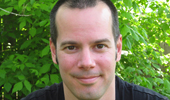Los Angeles Review of Books posted two reviews of Eric LeMay‘s In Praise of Nothing: Essays, Memoir, and Experiments (Emergency Press, 2014).
LeMay, Assistant Professor of Creative Writing: Nonfiction in the College of Arts & Sciences at Ohio University, published, In Praise of Nothing: Essays, Memoir, and Experiments.
…So when I discovered that Eric LeMay, in his book In Praise of Nothing: Essays, Memoir, and Experiments, had included an imitation of (E.B.) White’s own “Once More to the Lake,” I had to see for myself. To my delighted surprise, it wasn’t only that LeMay had mimicked the premise of White’s famous essay, but that his entire book reminded me, in various ways, of how White tackled his subjects.
LeMay not only displays mastery of the short form, but he’s also quick on his feet, knowing both when and when not to jab. And he knows how to lay on the heavy punches as well — the essays in In Praise of Nothing range from subjects like, well, nothing, to the distinctions between comedy and humor, to the history of John and Jane Does, to the AIDS epidemic.
Indeed, the essay is capacious. Collage, verse, narrative, sound, picture, video — all can be put in service to the inquiry and meaning-making essential to the genre. Creative nonfiction, as a field, has become fertile ground for experimentation with form, and In Praise of Nothing, which exists in several formats,romps about a full range of essayistic shapes. Some can be played online, as video games. Others can be watched and clicked through in an interactive back and forth of image and sound. Those printed in the book version contain their own textual and imagistic experiments. They are reflective, playful, elegiac, and often funny. This is the essay in the digital age, or whatever it is we are living through right now, and LeMay has put to use every instrument of expression he can to reach our senses.
The book opens with the title essay, which is set with visual interpolations — small frames from a webcam trained on a patch of gravel. Or is it the space, the nothing, so to speak, that outlines the horizon of rocks meeting the shrubs in the distance? The question is turned on the reader. Nothing, explained philosopher Martin Heidegger, is not simply negation; it has a presence that makes it possible for us to see something. Nothing allows us to better attend to the thing itself. “My ideal webcam, which I haven’t found,” writes LeMay,”would show people only indirectly, by them not being in, but still being signaled by, nothing. I imagine a crumpled beer can, discarded in a brick alley, where weeds have worked up between the bricks and gone raggedy, and every so often the shadow of a car or garbage truck sweeps by, and the can rusts gradually or gets coated with snow, so I can’t read the label.”



















Comments